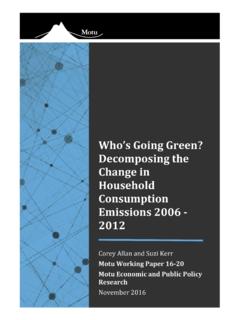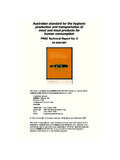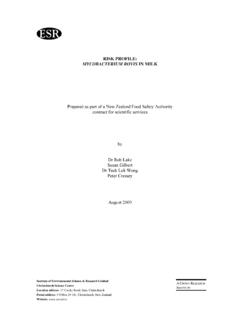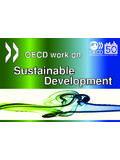Transcription of Greenhouse Gas Emissions in New Zealand: A Preliminary ...
1 Greenhouse Gas Emissions in New zealand : A Preliminary consumption - based analysis Carl Romanos, Suzi Kerr and Campbell Will Motu Working Paper 14-05 Motu Economic and Public Policy Research April 2014 i Author contact details Carl Romanos Stanford University Suzi Kerr Motu Economic and Public Policy Research Campbell Will University of Otago Acknowledgements Thanks to Bryan Field at MBIE, Adolf Stroombergen, Julia Hoare, Corey Allan, Sean Hyland, Simon Anastasiadis and Catherine Leining for helpful comments. This paper was completed at Motu under a Fellowship from the Stanford Environmental and Energy Policy analysis Center (Carl) and with support from the Motu Foundation (Campbell).
2 We are also grateful to the Aotearoa Foundation for support through the Shaping New zealand s Low-Emission Future programme. The authors are responsible for all errors and omissions, and any opinions expressed. Motu Economic and Public Policy Research PO Box 24390 Wellington New zealand Email Telephone +64 4 939 4250 Website 2014 Motu Economic and Public Policy Research Trust and the authors. Short extracts, not exceeding two paragraphs, may be quoted provided clear attribution is given. Motu Working Papers are research materials circulated by their authors for purposes of information and discussion. They have not necessarily undergone formal peer review or editorial treatment.
3 ISSN 1176-2667 (Print), ISSN 1177-9047 (Online). ii Abstract New zealand s per capita Greenhouse gas Emissions are usually calculated by taking total Emissions as reported under the Kyoto Protocol or the United Nations Framework Convention on Climate Change and simply dividing by population. However this focuses on Emissions associated with production within New zealand . From the point of view of individuals, these are not the Emissions they control, and hence can mitigate. Individuals can calculate their carbon footprint but tools to do this typically focus on a few categories of Emissions (mostly electricity, direct fuel use and waste) and Emissions footprints are not available for a wide range of households so cannot be used for comparative analysis .
4 This paper explores how the carbon Emissions related to the consumption categories of households in New zealand vary with household characteristics. We use product consumption data from the 2007 Household Economic Survey. consumption within each category is linked to a carbon intensity multiplier (tonnes of carbon dioxide equivalent per dollar of consumption ) which is derived from: the official 2007 input output table of 106 industries produced by Statistics New zealand ; energy data on carbon dioxide per petajoule of fuel in each industry from the Energy Data File; and the Energy Greenhouse Gas Emissions Report both provided by the Ministry of Business, Innovation and Employment.
5 Previous literature has used similar methods to calculate the incidence of a carbon tax ( Creedy and Sleeman [2006]). This paper uses these methods in order to study which sectors of household expenditure offer the greatest opportunities for mitigation and how these opportunities vary with household characteristics such as income decile, region and household composition. JEL codes D12; D62; Q41; Q01: Q54 Keywords Climate change, Emissions , consumption , household emissionsiii Contents 1. Introduction .. 1 Literature Review .. 3 2. Methodology .. 3 Fossil Fuel Emissions analysis .. 3 Process Emissions analysis .. 5 3. Data .. 5 Deriving the Vector of Fuel Emissions Factors (e).
6 5 Deriving the Matrix of Industry Fuel Requirements (F) .. 6 Process Emissions .. 8 Deriving the Matrix of Direct Requirement Coefficients (I-A)-1 .. 10 Calculating the Carbon Intensity Vector (c) .. 10 Converting Production Emissions to consumption Emissions .. 10 4. Caveats Limitations to analysis .. 11 Imports .. 11 Homogeneous Output Assumption .. 11 Government-Provided or -Subsidised consumption .. 12 5. Results .. 12 Income .. 17 Region .. 18 Household Composition .. 20 Number of People in 20 6. Conclusions .. 21 Observations .. 21 Moving Forward .. 23 7. References .. 24 8. Appendix .. 25 F Table (Energy Emissions Only) .. 25 c Vector (Including Process Emissions ).
7 27 1 1. Introduction Typically when Greenhouse gas (GHG) Emissions are reported by industry or per capita, the statistics are presented in a production- based way which isn t necessarily meaningful to consumers in relation to their own behaviour. Also, production-related Emissions are only one way to measure the benefit that a country or individual gains from Greenhouse gas Emissions , and only one way to track efforts to reduce Greenhouse gas Emissions . Reports of industry Emissions tell individuals where the GHG Emissions come from, and calculations of per capita Emissions derived from production Emissions give individuals some idea of the magnitude of their Emissions , but they do not tell individuals what Emissions they are personally responsible for.
8 From the standpoint of a consumer, consumption - based Emissions are the full scope of Emissions they can control and take steps to mitigate. This paper uses a simple method to calculate consumption - based Emissions for different types of New zealand households. We focus on how consumption by different households in different categories affects GHG Emissions rather than attempting to provide an accurate measure of total consumption Emissions . This information helps consumers understand how their current consumption profile affects their GHG Emissions . This is especially important as individuals look for concrete personal steps they can take to reduce their carbon This information can serve to counter the culture of paralysis surrounding the thought of GHG Emissions as a societal or firm-level problem.
9 Furthermore, the study helps us observe how consumption Emissions vary over differing household characteristics. This is helpful on a higher level as it helps us see patterns across characteristics such as income deciles or differing household compositions. These descriptive statistics provide insight into Emissions patterns in New zealand and what sort of future action may be fruitful on a scale that both policy makers and the general population can better understand. We relate production- based Emissions to consumption using an approach that combines an input output (IO) model with a household expenditure survey using carbon intensities (tonnes of carbon dioxide equivalent [CO2-e] per dollar of output in every industry of the economy).
10 The model is based on the input output table, which keeps track of inter-industry transactions. The input output model tracks both fossil-fuel and non-fossil-fuel Emissions throughout the entire economy, accounting for both intermediate and final products. The input 1 In this paper, the popular term carbon footprint typically refers to GHG Emissions reported on a carbon-dioxide-equivalent basis. 2 output model is used to calculate the carbon intensity vector which can directly convert average household expenditure to average household Emissions once industries are matched with consumption categories.






